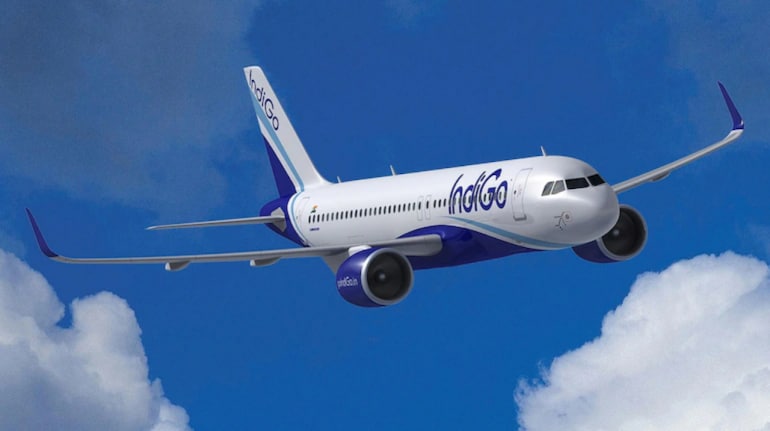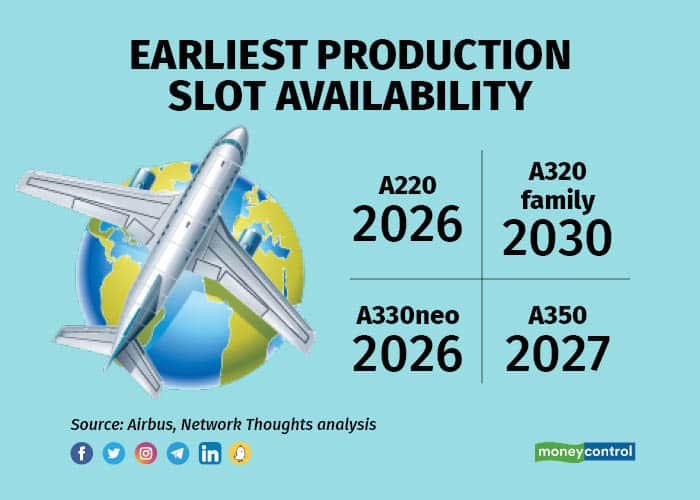



The last few months have seen Air India make more news than IndiGo, the country’s largest carrier by fleet and domestic market share. IndiGo has since been in blitz mode, with CEO Pieter Elbers communicating with the press more often and talking about expansion, among other things. This also saw a few media outlets misinterpreting the number of planes already on order as being a new order of 500 planes.
Within days of this, IndiGo was in the news again, this time for a possible order with Airbus. Neither IndiGo nor Airbus spoke about this but the comment came from a French minister, who was in India for the G20 summit meetings.
That throws up an interesting question, why would IndiGo place an order now if it has enough aircraft to cover its induction plan for the next five to seven years? The answer lies in the large backlog Airbus has right now for the A320 family.
Airbus has a backlog of over 6,000 planes for the A320 family, which includes the A319neo, A320neo and various versions of the fast-selling A321neo. A look at the numbers at the end of January, along with numbers for the Air India order and a reinstated Qatar Airways order, shows that the backlog for the A320neo family stands at more than 6,300, while that of the A330neo is close to 200. The A350 backlog is at over 450 and the A220 at over 500.
Airbus has been pushing up the monthly production rate for all its aircraft over time. The process, which had started pre-COVID, faced a major setback due to the pandemic as supply chains came to a standstill during the pandemic and have still not recovered. And yet, last year it delivered planes averaging over 50 a month.
But the ambitions are bigger. The aircraft maker plans to ramp up production of the A320 family to 75 planes a month by 2026. At that rate, it would have produced more A320 family aircraft in a year than the entire fleet of scheduled Indian carriers.
The A350, which is clawing back the widebody market from Boeing, is also slated for a ramp-up by the end of 2025.

A look at the numbers shows that these are just firm orders. Airlines also have options as part of the orders, which typically have a production slot identified and come with a deadline on when to confirm the slot.

Order now, get it later
A look at the order book and mapping it against the production rate estimates shows that the earliest available slot for the A320neo family is in 2030. In simple terms, if an airline wants a plane in 2030 it has to place an order now. With IndiGo having made clear that the current order takes care of the next five to seven years, it has to think beyond that period now or risk losing out on production slots and lucrative deals.
There are other ways of getting an aircraft. Lessors place large orders from time to time and market planes to airlines. Vistara, for example, placed a large order, which was split between OEMs and lessors. However, that robs the airline of the potential of sale and leaseback income, which has fuelled growth in Indian aviation over the last decade, if not more.
While each order has a clause built in for an increase in rates linked to inflation numbers, the total cost still turns out cheaper with an advance order than buying closer to the production slot. The latter eventuality probably played out with Boeing’s MAX, largely due to the problems it faced getting back in the air post the groundings following two deadly crashes.
That regional feeling or Boeing?
A lot has been said about the small jets segment. Airbus and Embraer have wooed airlines but none has bitten the bullet, yet. One of the reasons often cited for the lack of sales for the A220 in India is availability, but a look at firm orders shows that the A220 will be available earlier than the A320 family.
Pieter Elbers, the current CEO of IndiGo, was at the helm of KLM before joining IndiGo. KLM operates the Embraer E2 family and group airline Air France operates the A220. Both have a steady order book of both types in this segment.
As of today, Boeing has a large availability of MAX whitetails (over 200 planes that are built and ready to fly as the original buyers did not take them). While it is believed that it has given lucrative deals to airlines willing to absorb that inventory, will IndiGo move to a multi-aircraft model? Both full-service carriers and low-cost carriers have gone with either Airbus or Boeing for their narrowbody requirements. A new type does add to the challenges in operations, but the end objective of an LCC like IndiGo is to have the lowest cost. In a market where profits have been as thin as boarding cards, the only differentiator is the lowest input costs.
One thing is clear: to start receiving planes in 2029 and beyond, when the current fleet will be due for replacement, IndiGo has to place an order sooner rather than later.
Discover the latest Business News, Sensex, and Nifty updates. Obtain Personal Finance insights, tax queries, and expert opinions on Moneycontrol or download the Moneycontrol App to stay updated!
Find the best of Al News in one place, specially curated for you every weekend.
Stay on top of the latest tech trends and biggest startup news.